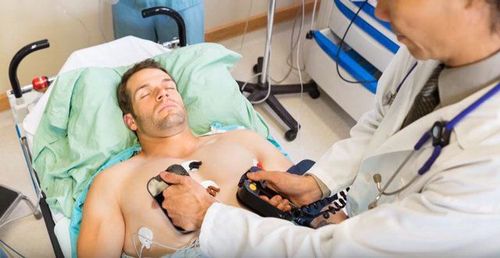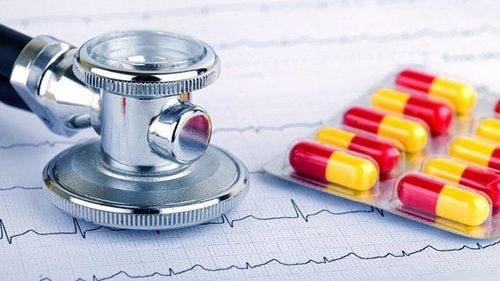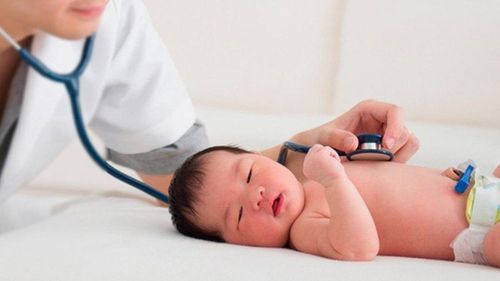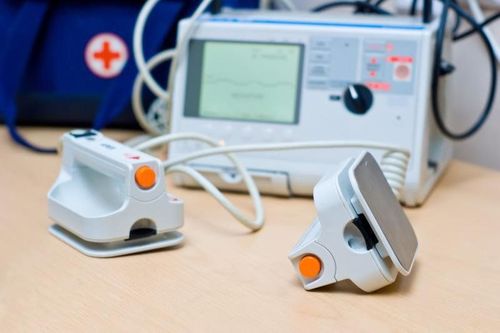This is an automatically translated article.
The article was consulted with Specialist Doctor I Huynh Kim Long - Emergency Resuscitation Doctor - Emergency Resuscitation Department - Vinmec Danang International General Hospital.Acute heart failure including acute pulmonary edema or cardiogenic shock is a pathology in cardiovascular resuscitation. Acute heart failure usually has a primary onset of decompensated acute heart failure on the background of chronic heart failure. Diagnosis and management of acute heart failure should be carried out urgently and effectively. If not treated promptly, the patient can die quickly.
1. Symptoms of acute heart failure
1.1. Physical symptoms
Shortness of breath. Dyspnea appears on exertion, late stage dyspnea even at rest, paroxysmal nocturnal dyspnea (sudden onset of dyspnea in sleeping patient, feeling of suffocation, patient has to prop a high pillow or sit up to breathe) Rapid breathing, respiratory muscle contraction Panic, sweating Dry cough often occurs at night or during exertion Cold limbs, pale skin Other symptoms such as chest pain, palpitations, palpitations , fatigue, dizziness, headache, insomnia, memory loss, ...
1.2. Physical symptoms
Tiny, moist granules rise rapidly from the 2 bottoms of the lungs to the 2 lung fields like a tidal wave in the lungs. Heart can be heard galloping, tachycardia pleural effusion Peripheral edema Abdominal distention, hepatomegaly, sclera eyes yellow Floating jugular vein Low blood pressure Narrow pulse pressure or low gradient Circulatory pulse2. Diagnosis of acute heart failure
The initial diagnosis of acute heart failure should be based on clinical symptoms, predisposing risk factors for acute heart failure such as concomitant cardiovascular disease, and evaluation for signs of congestion and/or hypoperfusion by physical examination.Tests to help diagnose acute heart failure include:
Straight chest x-ray: Enlarged heart, pulmonary venous congestion, pleural effusion, interstitial or alveolar edema. Kerley B line can be seen due to edema of the interstitial spaces of the lymphatic system, the butterfly image is seen in acute pulmonary edema. Electrocardiogram helps to diagnose the cause or predisposing factors for acute heart failure such as atrial fibrillation, acute myocardial ischemia, signs of increased ventricular and atrial load, etc. Emergency echocardiography is required only in patients with acute myocardial infarction. hemodynamic disease (especially in cardiogenic shock) and in patients with suspected life-threatening structural or functional cardiac abnormalities (mechanical complications, acute valvular regurgitation, aortic dissection) . Blood tests:
BNP and derivatives test: measure diuretic peptide levels (BNP, NT-proBNP or MR-proANP) in all patients with acute dyspnea and suspected acute heart failure to differentiate heart failure acute with noncardiac causes. Diuretic peptides have high sensitivity and normal concentrations in patients with suspected acute heart failure. BNP, NT-proBNP, MR-proANP are elevated. Cardiac troponin helps detect acute coronary syndrome, a cause of acute heart failure. Increased cardiac troponin levels are detected in the majority of patients with acute heart failure.
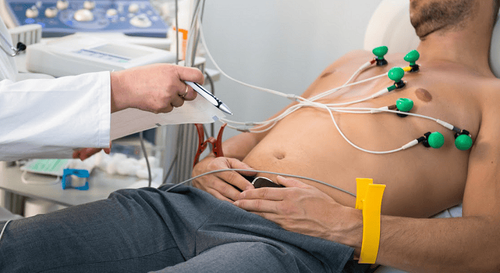
3. Treatment of acute heart failure
Treatment goals of acute heart failureEmergency management of respiratory and circulatory failure Combined treatment of the cause Symptomatic treatment If the patient has respiratory failure or cardiogenic shock requiring intensive resuscitation and transfer the patient to the intensive care unit. In case of mild acute heart failure, it is necessary to assess the airway, ventilate, give oxygen to the patient, place an intravenous line, administer medication, assess vital signs, and monitor the patient's urine. Treatment of acute pulmonary edema
Give the patient oxygen. Place an intravenous line immediately Depending on each specific case, there are different treatment indications. Using drugs according to the regimen such as: diuretics Furosemide, Nitroglycerin, Morphine Sulfate. Use vasopressors such as Dobutamine, Dopamine if hemodynamically unstable Non-invasive ventilation in case of response Intubation if severe hypoxemia does not respond to treatment and respiratory acidosis After the patient temporary stabilization should find a way to determine the cause for long-term treatment. Treatment of cardiogenic shock
Causes of cardiogenic shock include damage to the heart muscle, heart valves, chambers, or arrhythmias. Treatment measures include:
Give the patient oxygen. Endotracheal intubation if necessary Use intravenous vasopressors such as Dopamine, Dobutamine, Milrinone, Noradrenaline Intubation of aortic counterpulsation balloons Support circulation by mechanical methods, assist devices or membrane systems Extracorporeal oxygen exchange Coronary revascularization when indicated such as coronary bypass surgery, dilation and stenting if cardiogenic shock due to myocardial infarction Acute heart failure emergency should be performed urgently depending on the specific situation . After taking the above measures, it is necessary to continue treatment to improve the patient's hemodynamics, clinical symptoms of acute heart failure. Patients need to be adjusted their medications and monitored hemodynamically, weight, and volume of fluid in and out each day for the patient to ensure optimal effectiveness.
Vinmec International General Hospital has a team of doctors and emergency nurses at the Emergency Department who are highly trained and methodical, able to receive and urgently handle severe cases of patients. Continue to coordinate monitoring and treatment in the ICU with modern machines such as: PiCCO invasive hemodynamic detector, non-invasive ventilator, GE Carescape R860 ventilator... With basic system Modern medical equipment and facilities combine a team of cardiologists and thoracic specialists in medical treatment in combination with coronary intervention with a modern DSA system.
Please dial HOTLINE for more information or register for an appointment HERE. Download MyVinmec app to make appointments faster and to manage your bookings easily.





